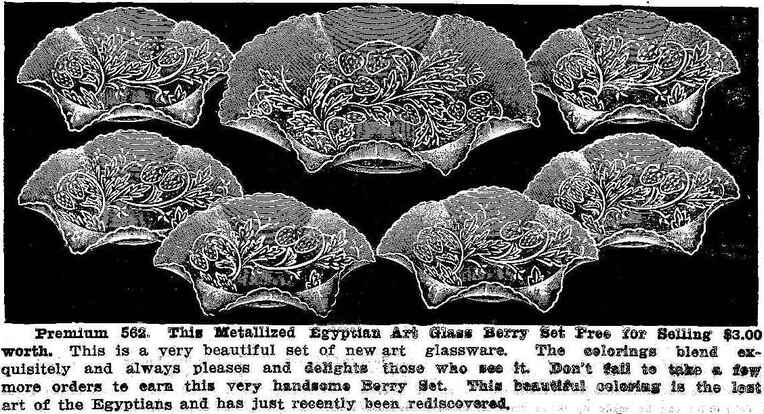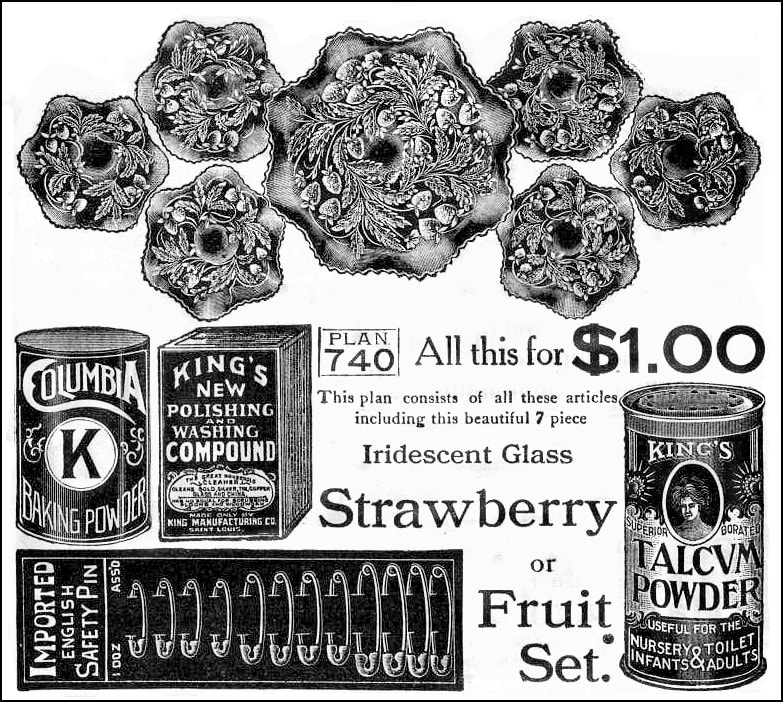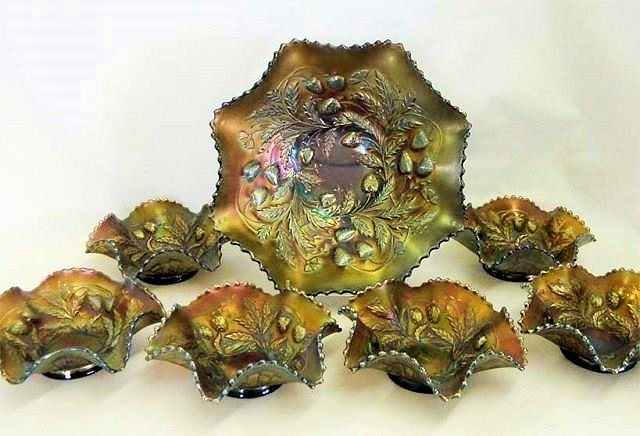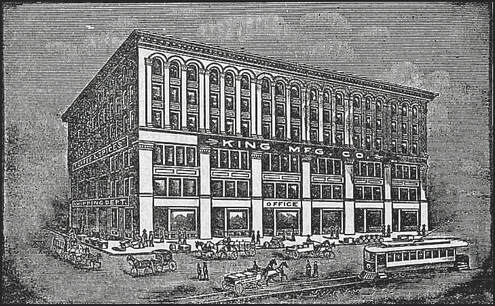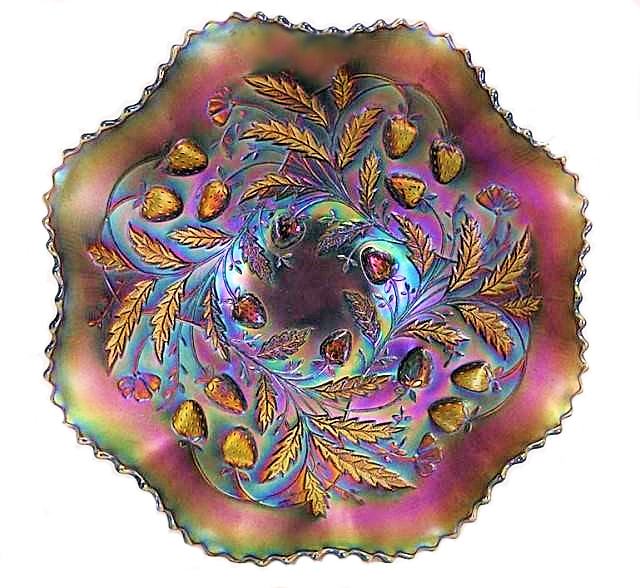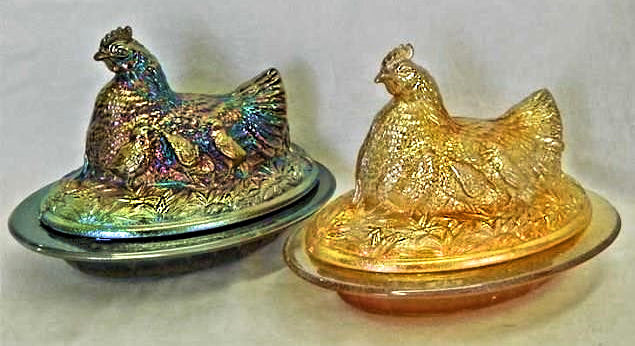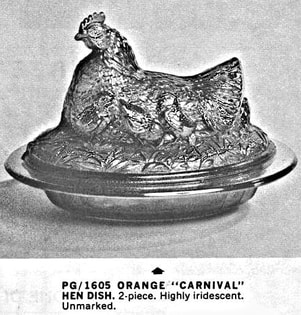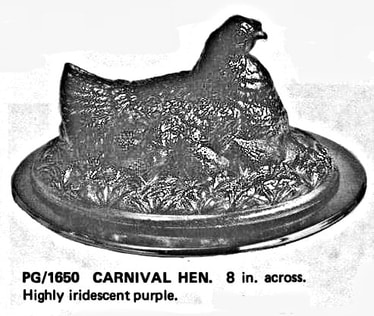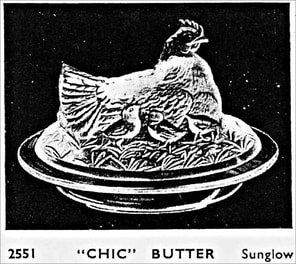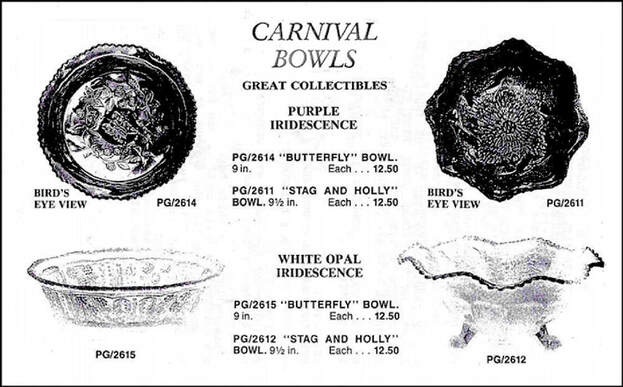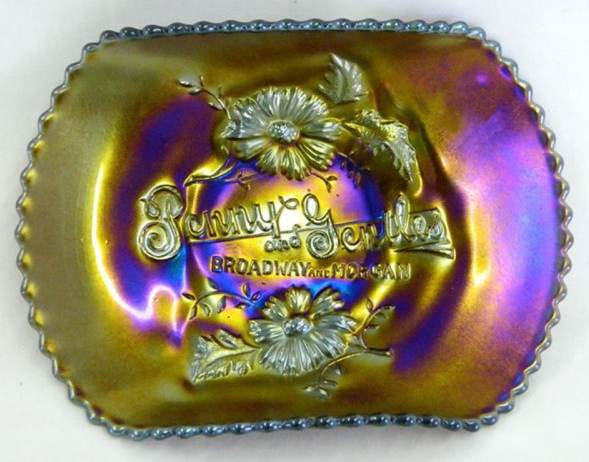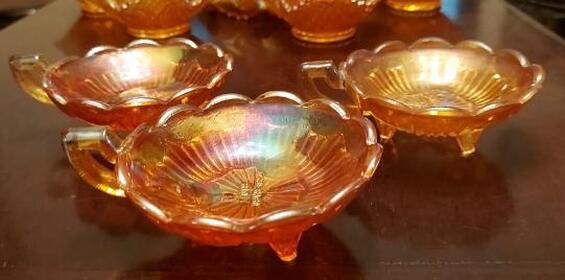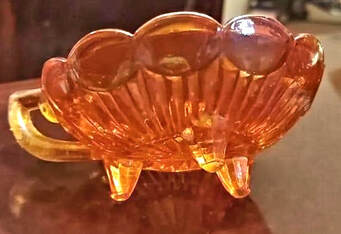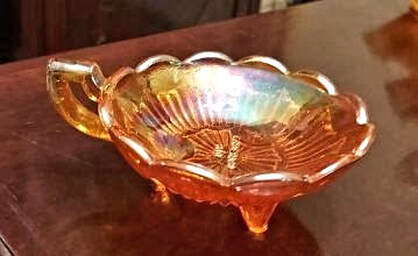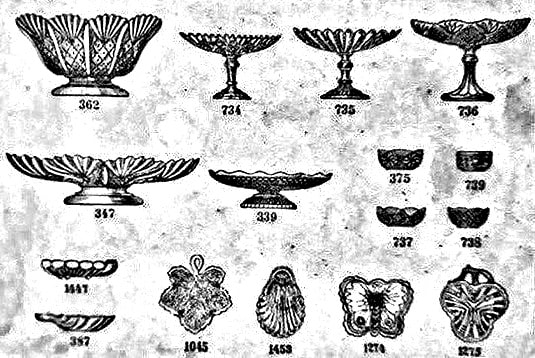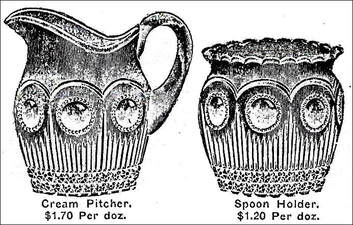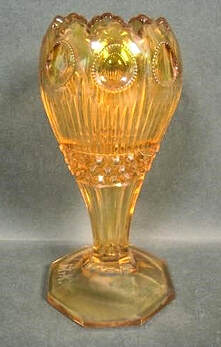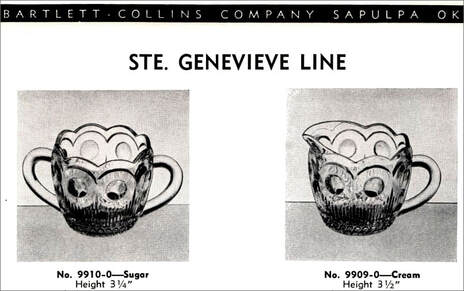NetworK ezine Issue 78. November 2021
Totally Devoted to Carnival Glass
|
It’s believed that the Ancient Egyptians were among the first to invent glass, and indeed were making it around 3500 years ago (give or take a few years!)
They were able to colour the glass using metallic oxides, and although it wasn’t until more recent years (1800s) that iridescence was purposely applied to glass, ancient examples have been found that have naturally become iridescent. And so, when Carnival Glass was first made in the early 1900s, one of the promotional terms used to advertise it – and make it appear most desirable and rare – was what you see in the header: “Metallized Egyptian Art Glass”. The Glass The splendid pattern illustrated in the ad on the right and referred to as a “very handsome berry set” was Northwood’s Wild Strawberry. Look closely and you can see the tiny flowers amongst the berries (these flowers distinguish Wild Strawberry from Northwood's regular Strawberry pattern). |
Above: a Wild Strawberry berry set as shown in the King Manufacturing Co. Catalog of premiums.
There was no date given, but the Carnival items shown date from 1909 onwards. Courtesy Jon D Bartell and the Glass Paper Fanatics. |
The explanatory text in the King Manufacturing Co. ad above is fascinating: “This beautiful coloring is the lost art of the Egyptians and has just been recently rediscovered”. As we explained above, the Ancient Egyptians did not purposely iridise their glass, so what King was alluding to was undoubtedly the introduction in the early 1900s of iridescent pressed glass (that is, Carnival Glass). In the King Manufacturing ad above, the full berry set was offered free to their sales agents, for “selling $3.00 worth” of goods from the catalog.
In the same King Manufacturing Catalog from around 1909, we see another Wild Strawberry berry set (below, left), but this time it is offered as part of a sales premium plan (no. 740). In the plan, the set was offered alongside baking powder, safety pins, washing compound and talcum powder, for just a dollar! Notice how the depiction of the Wild Strawberry pattern is quite different on the two ads. On the first, it’s simplified and rather basic – but the second one is much more realistic and fulsome in its beautiful portrayal of the lovely Northwood design.
|
The term “Metallized Egyptian Art Glass” (referring to what we know as Carnival Glass) was just one of many names given to iridescent pressed glass at that time. It also became known as “Baking Powder Glass” – the source of which is clear from the illustration of Plan 740 above. Baking Powder was one of the frequently sold items that was offered to customers as part of a deal to get Carnival. You can read much more about the many varied (and sometimes bizarre) names Carnival was called in our feature article: Carnival Glass - What's in a Name? The King Manufacturing Company |
Above: Wild Strawberry large berry bowl, purple.
Courtesy Seeck Auctions. Left: Illustration on the cover of King Catalog No. 30 (undated, but possibly c. 1909). Courtesy Jon D. Bartell and the Glass Paper Fanatics. |
So, what do we know about the King Manufacturing Company?
Their address was 1421 Olive Street, St. Louis, Missouri, which we believe (through studying the street map) was located about ¾ of a mile due west from today’s St. Louis Arch on the Mississippi River – and is currently the location of a parking lot adjacent to the St. Louis Public Central Library. Local residents can possibly advise if we are correct about this.
Despite advertising themselves as a “Manufacturing” company, it is unlikely they actually manufactured any goods. They operated a premium plan business, using agents to sell the goods in their catalogues. The goods would be sent to their agents by free shipping (as Kings said “We bear the expense of freight charges”) and the payments would be collected and submitted to the parent company. Agents would be compensated by receiving free goods (premiums) and/or a cash commission. Note in the illustration of the King Manufacturing building above, “Office” and “Shipping Dept.” are prominent. Much of the space inside the premises would also have been used for goods storage.
In a previous issue of our NetworK ezine we were delighted to share another ad from this intriguing company, courtesy of Joan Doty and the late Don Moore. On offer was a Northwood Tree Trunk vase with a very surprising herbal medicine. You can read it here, from February 2021: NetworK Issue #69
You can also read more about another prominent Mail Order and Premium marketing company, Lee Manufacturing here: Carnival Glass at a Premium
Their address was 1421 Olive Street, St. Louis, Missouri, which we believe (through studying the street map) was located about ¾ of a mile due west from today’s St. Louis Arch on the Mississippi River – and is currently the location of a parking lot adjacent to the St. Louis Public Central Library. Local residents can possibly advise if we are correct about this.
Despite advertising themselves as a “Manufacturing” company, it is unlikely they actually manufactured any goods. They operated a premium plan business, using agents to sell the goods in their catalogues. The goods would be sent to their agents by free shipping (as Kings said “We bear the expense of freight charges”) and the payments would be collected and submitted to the parent company. Agents would be compensated by receiving free goods (premiums) and/or a cash commission. Note in the illustration of the King Manufacturing building above, “Office” and “Shipping Dept.” are prominent. Much of the space inside the premises would also have been used for goods storage.
In a previous issue of our NetworK ezine we were delighted to share another ad from this intriguing company, courtesy of Joan Doty and the late Don Moore. On offer was a Northwood Tree Trunk vase with a very surprising herbal medicine. You can read it here, from February 2021: NetworK Issue #69
You can also read more about another prominent Mail Order and Premium marketing company, Lee Manufacturing here: Carnival Glass at a Premium
|
A.A. Importing Company Coincidentally, our next feature also takes us to Olive Street in St. Louis, Missouri – to the A.A. Importing Company Inc. founded in 1934 by A.A. Gralnick. The company’s own website tells us that they were first located in the Gas Light Square area of St. Louis, and their origins were in the distribution of kerosene lamps and accessories. Some years later they began to import “fine crystal and art glass”. Back in the 1970s, they were also selling imported Carnival Glass through their distribution centre at 4244-48 Olive Street, St. Louis. The reader might question why we have chosen to place an image of Sowerby’s Carnival Covered Hen butters here, at the start of this feature. The answer might surprise you! |
Sowerby Covered Hen butter dishes in blue and marigold, courtesy Seeck Auctions.
The original Sowerby name was “Chic” Butter. |
In the 1970s, ads appeared in the A.A. Importing Company’s Catalogs for items that we feel were almost certainly the marigold and blue Sowerby Covered Hens. The “Orange Carnival” Hen shown below on the left appeared in 1971; it was surely what Sowerby called their “Sunglow” marigold Carnival.
Then, in 1976, a “highly iridescent purple” Hen appeared - below, right. It says that the Hen was purple, but it was almost certainly blue base glass with much purple in the iridescence. This was Sowerby’s “Rainbo” iridescence which had deep blue and purple hues, as seen in the blue Covered Hen image at the top of this article.
Then, in 1976, a “highly iridescent purple” Hen appeared - below, right. It says that the Hen was purple, but it was almost certainly blue base glass with much purple in the iridescence. This was Sowerby’s “Rainbo” iridescence which had deep blue and purple hues, as seen in the blue Covered Hen image at the top of this article.
Despite the poor image quality, it’s easy to see that these Hens are the same shape and detail as the Sowerby Covered Hen (despite the missing part of the “iridescent purple” hen’s head, which appears to be caused by lax “cut and paste” graphics from 40 plus years ago).
|
So, what was going on? Firstly, it is important to note that Sowerby first made their Covered Hens in Carnival in the 1920s, but that they also made them again later, in the 1950s. The extract on the right is from a 1956 Sowerby catalogue. We recall lengthy, published (and sometimes rather "difficult") discussions in the 1980s, about a veritable flood of so-called Sowerby Hens appearing in the USA. The explanation being offered was that they were actually from an old storage of blue Carnival Covered Hens that had just been “discovered”. However, a more likely explanation is that the Hens being marketed by in the 1970s, were actually ones that were made by Sowerby in the 1950s (or possibly earlier) and had been imported into the USA by A.A. Importing Co. The question is "Why did they end up with A.A. Importing in the 1970s?" After World War 2, Sowerby's struggled financially. Eventually, the business was sold to Suntex Safety Glass Industries Ltd. and much of the stock and inventory was disposed of. A likely answer could be that A.A. Importing bought up some of Sowerby's old stock of Hens and marketed them in the USA. |
Extract from a 1956 Sowerby catalogue.
|
A.A. Importing is also known for importing the controversial Stag & Holly and Butterfly & Berry Carnival bowls. They were made in Korea, and the first reported sightings were in the early 1980s. One of the original ads for them is show below.
A.A. Importing is also known for importing the controversial Stag & Holly and Butterfly & Berry Carnival bowls. They were made in Korea, and the first reported sightings were in the early 1980s. One of the original ads for them is show below.
You can read all about these here: Stag and Holly Fakes
|
Penny and Gentles Let’s continue our stay in St Louis and take a look at the Penny and Gentles store. The company was a thriving “Dry Goods” department store that had suffered fires in 1891 and 1900. A few years later, basking in the wake of the World’s Fair success in St Louis, Penny and Gentles initiated a number of promotional schemes to increase sales including free tram rides to their store and the use of splendid advertising items in Carnival Glass. We don’t know the date of this rare Northwood Carnival Advertising piece (our understanding is that just two are reported) but it would appear to have been part of a sales “push” by the company to regain ground after the two, disastrous fires. For a company that gave away free jackets (with the purchase of a skirt), free tickets to the Amusement Park and books of 100 labels free to every purchaser of a dozen Mason Jars, the unusual and decorative Carnival Advertising plates were surely part of Penny and Gentles successful marketing strategy. You can read all about it, and maybe help us to answer the (so far) unanswered questions, here: Penny and Gentles – The Story Behind the Glass |
Northwood's rare amethyst Penny and Gentles double handgrip plate, courtesy Seeck Auctions.
|
A Discovery in Brazil
Photos courtesy of Thiago Zanette.
Photos courtesy of Thiago Zanette.
We were recently contacted by Brazilian Carnival Glass researcher, Claudio Deviekis, with exciting news about a fresh discovery. Claudio’s friend, Carnival collector Thiago Zanette, had found three delightful handled dishes that had not been seen before (see Thiago’s photos right, and below).
Claudio was able to locate the exact item in the Esberard catalogue – you can see it on the left side, third item down – number 3447. It’s a small item of tableware, possibly for snacks or bonbons, or as Claudio suggests, for discarded fruit sections, peel, seeds etc., that would be served after the main meal.
This Esberard pattern has a familiar feel to it to us, which led us to wonder if perhaps it was inspired by the United States Glass popular design “Manhattan” (which was introduced c.1902).
This Esberard pattern has a familiar feel to it to us, which led us to wonder if perhaps it was inspired by the United States Glass popular design “Manhattan” (which was introduced c.1902).
|
Although the Chippendale style (flat-topped) handles of the Esberard piece are very different to Manhattan, and aspects of the pattern are not alike, but there’s a possibility that the Esberard design was inspired by the well-known Manhattan design. Above: United States Glass “Manhattan” pattern, No. 15078.
Right: some scarce items are known in marigold in the Manhattan design See footed vase on the right, picture courtesy of Burns Auctions. |
|
And for an interesting twist on this pattern, did you know that Bartlett-Collins copied the Manhattan design in the 1960s (but it was not made in Carnival Glass)? They called it Saint Genevieve.
Right: Bartlett-Collins Catalog. Courtesy Jon D Bartell and the Glass Paper Fanatics. See much more about the amazing Carnival Glass from Esberard in Claudio's excellent feature on our website: Esberard by Claudio Deveikis Claudio also has an excellent blog site where you can read more about this discovery: Claudio's Blog |
We are celebrating! Five Years of NetworK on Facebook and almost 12,000 members!
On October 24th., 2016 we began our Carnival Glass NetworK Facebook Group. That was five years ago, and now we have almost twelve thousand people from all around the world. People who who enjoy looking at, learning about and sharing their Carnival Glass. We have members in every continent, and every day is a journey of learning even more about our glass. Hats off to all our truly wonderful members – you are the very best.
If you are not a member of our Facebook Group, why not join us? Here is the application link: NetworK Sign-Up
On October 24th., 2016 we began our Carnival Glass NetworK Facebook Group. That was five years ago, and now we have almost twelve thousand people from all around the world. People who who enjoy looking at, learning about and sharing their Carnival Glass. We have members in every continent, and every day is a journey of learning even more about our glass. Hats off to all our truly wonderful members – you are the very best.
If you are not a member of our Facebook Group, why not join us? Here is the application link: NetworK Sign-Up
If you have missed any of the previous issues of NetworK and NetworK Specials, they are all here: Back Issues.
Privacy and the use of your information: we only use your name and email address to send you your FREE Carnival Glass NetworK ezine. We will not share your name or email address with anyone else, or use it for any other purpose. You can change your mind about receiving your NetworK ezine at any time by clicking the unsubscribe link at the foot of every issue, or by emailing us at [email protected]
Join us on Facebook
We would love you to come and join in the fun, and we invite you and your friends to join us all on NetworK's fast growing and very active Facebook Group!
We would love you to come and join in the fun, and we invite you and your friends to join us all on NetworK's fast growing and very active Facebook Group!


